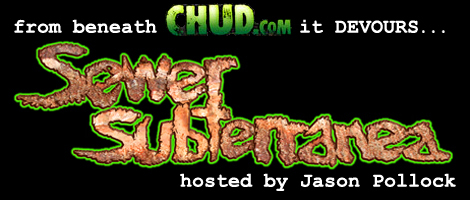
Once, long ago…I was chummy with a convention-floor bootleg king I will refer to only as “Badness”. Badness and I would run into each other in Chicago, Detroit, New York, Los Angeles – wherever there was a convention to hit, Badness would be there – shilling “Swill for the Mentally Ill.”
Understand, in the days before rampant (and so very hurtful) online piracy, the only way you’d see a lot of the rare and the weird was to pore over mail-order bootleg catalogs and hit the convention trail to find dubbed VHS tapes. Most of them were seventy-third generation abortions, but Badness never played you like that. He was always on the hunt for the best source material possible, and it didn’t take long for him to become the only guy I dealt with. He was the guy that could get you a copy of Salo: 120 Days of Sodom. Badness had Seven Doors of Death uncut.
Badness…was the man…brings you – Jacky Chan.
It got to the point that I’d get home from school and bum-rush the mailbox looking for my weekly order – and there’d always be something odd and unexpected.
Like the time he sent me a set of VHS tapes with the entire batch of step-frame laserdisc extras from the Criterion Collection release of The Killer. He moved through each page at a perfect reading clip, and he layered in a bunch of Beastie Boys and Big Daddy Kane and Tim Dog…
And at the end of the tape – just to kill some time – he clipped a couple seconds out of The Killer – when Ah John, Jenny, and Detective Li are ambushed by the White Jumpsuit Apparatus at Sidney Fung’s place…and they beat a retreat back through the kitchen…and Ah John grabs a butcher knife, pins a white shirt to the kitchen table, and stabs him through the shoulder blade – Badness re-cut the sequence to make it look like Chow grabs the knife, stabs the guy, removes the knife, stabs him again, lifts him from the table, rams him back down, stabs him again, and again, and again…lifts him, rams him…
Of course he set it to Carpenter’s Halloween theme. Oh, did we laugh…
Maybe you had to be there…?
And there was always the Mystery Tape. With the Badness Mystery Tape, you knew two things:
1) It was going to be one of the most awesome things you’d ever see, and-
2) It was best viewed amongst friends.
It became the sort of thing where you’d have people over…and the night was winding down…and you’d gather everyone around the screen and tell them that Badness sent something new. One night, in the summer of 1993, a batch of us settled in around my spiffy new wood-grain accented, seven-ton 52″ Toshiba projection screen as I tapped “play” on a Badness Mystery Tape.
The presentation began, as many did, with a bit of a warm-up – in this case, the music video for Tim Dog’s “Step To Me” – from the legendary Penicillin on Wax. Go find that now. Fuck Compton.
And then…we were treated to a film that, for me, has kept on giving after thirteen years. We watched Fight For Your Life.
Fight For Your Life is a textbook – just…textbook – example of the nasty nature of 70’s b-movies. I can’t think of another explo-flick from that period that does a better job of beating you about the face and neck with its stated intent (some would say Thriller: A Cruel Picture a.k.a. They Call Her One Eye far exceeds FFYL on the vile scale – but that’s just because of the unwatchable 70’s furry-people hardcore sex tossed into the film, seemingly as an afterthought). Fight For Your Life is so vile that the film failed to make any real money – because distributors feared showing it.
We’re introduced – with speedy and brutal economy – to a group of criminals in an NYPD “paddy wagon”. It’s the Rainbow Coalition of Convicts – Chino the Latino (Daniel Faraldo of Above the Law), angry Asian Ling (Peter Yoshida, late of ROUNDERS), and cracker-ass “Donka” Jesse Kane – brought to immortal life by character actor extraordinaire William Sanderson.
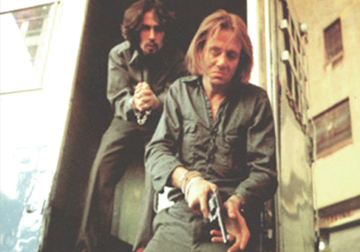
It’s no mistake that this ruthless little drama “colors” the frame as it does, because these characters are going to be dropped into the sociological Petri dish in about twenty minutes. The gang breaks free in an odd bit of coincidence (involving a loitering robber, an angry pimp, and a beauty bit of undercranking), and they set out on a crime spree en route to Canada.
After that bit of setup, we’re intro’d to Lieutenant Riley – or “Rulebook” Riley as he’s referred to by cop and perp alike, since every move he makes seems to have been informed by watching episodes of Jack Webb’s Dragnet. Riley is a personality vacuum – a no-nonsense, by-the-book Detecto who has tangled with Kane and his compatriots before. Once the Cross Colors Crew is on the lam, Riley’s on their trail. After interviewing Kane’s ex-cellmate (which is not much more than exposition that sets up Riley’s character – he busted the guy in the cell for possession, despite the fact that the hophead’s old man saved Riley’s life in Korea – so now we understand how hard-line unwavering he is), he sets out on the trail of the Rainbow Connection.
From there, we drop in on the Turner family. Patriarchal minister Ted (Robert Judd, who would – perhaps ironically – go on to play Satan himself in Walter Hill’s minor classic Crossroads. Shortly thereafter, he received an audience with God…’cause, well – he died), his wife Louise (Catherine Peppers), daughter Corrie (Yvonne Ross), Granny (Lela Small) and battlin’ boy Floyd (screenwriter/director Reggie “Rock” Blythewood of Get on the Bus and Biker Boys fame, in his first brush with the movies). The family is gathered round the dinner table as Ted rehearses his sermon. Granny’s tired of fire and brimstone – she thinks Black Power’s where it’s at. Floyd’s inclined to agree with Nana, as he leaps up on his chair and raps like Cassius Clay. I’ve always found the film’s introduction of the family strangely out of character for an exploitation flick. It’s actually really well -ritten and – for the most part – very naturally performed (Judd’s a bit overwrought – but it could be argued that it’s a choice he made for the character). One very cool exchange comes between Corrie and her mother, when mom discovers that her daughter has invited Caucasian Karen (Bonnie Martin) to dine with the fam tomorrow night. Mom is less-than-thrilled that she’ll be having crackers for dinner. Corrie explains that Karen is practically a member of the family, since she was engaged to Val – the Turner’s eldest boy, who was tragically killed in a car accident (we later see some semblance of the crash in flashback – oddly juxtaposed with an interracial love scene that’s no less of a wreck).
Again, this scene is entirely expository – but it’s nicely handled. And I like the moment of racial discord struck in the sequence, as it feels very honest to me. This older woman would have lived through a much darker time in the struggle for equality, and she might not be so ready to receive a honky in the house. Meanwhile, daughter Corrie represents the more progressive view that being a child in (not of) the ’60’s might have created, and sees absolutely no reason not to be inclusive.
The next day, the Can’t-Get-Along Gang has made its way upstate – robbing and stabbing all the way – and when they walk into a liquor store for a cash grab, things go pear-shaped. The clerk grabs a gun, Kane is forced to draw down on him (though everything you know about the greasy little rope-belted bastard says he’d have done it anyway, y’know – for kicks), and the boys take a hostage in Corrie, who happened to stop in to pick up a bottle of wine for dinner tonight.
After Kane guns down the liquor store clerk, he turns his attention to a baby seated in a high-chair near the counter (apparently, it was Bring Your Baby to Booze Mart Day), cocks the hammer on his revolver, and puts the gun to the toddler’s head.
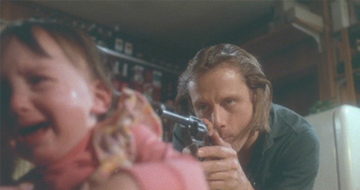
Are you fucking kidding me, movie?! Did you really just do that?? Even the rapist/murderers Kane is traveling with can’t handle this turn of events, and they beg him not to pull the trigger…
The criminals force Corrie to take them back to the Turner homestead, where they can hide out until such time as they feel they can safely make a run for the border. Once there, Kane and the Gang proceed to psychologically and physically torture the Turners, and the film becomes full-on, balls-out craziness.
Kinda.
Granted – there are two separate incidents of rape – but they are mercifully either implied or shot in a tame fashion (“tame” when compared to other exploitation films of the day), and a child is killed – but these incidents of cruelty aren’t what grants the film legendary status – or finds it on that list of rare films still considered “Video Nasties” in the U.K. to this very day.
In point of fact, the craziness of which I speak is – pretty much – thirty minutes of people sitting around talking. It is in those stretches of Fight for Your Life that you will find some of the most vicious racist tirades ever committed to celluloid.
Having shown this film to people on multiple occasions…having watched it countless times, I still find myself shaking my head in amazement over some of the utterly insane dialogue given to Jesse Kane. I don’t want to give any of it away – nor, honestly, do I feel comfy typing most of it – but when Kane aims his .45 at Ted Turner’s feet, fires a round, and tells him to “dance”…and Judd-as-Turner makes with a saddening display of the type of minstrel show-style shuffle-step Hollywood loved in the ’30’s and ’40’s…and Kane laughs and says he’s “never seen a jig dance a jig before“ – you know you’re watching something exceedingly fucked up.
And it’s amazing – because somehow…the murders…the rapes…the violence – none of the horror visited on the Turner clan hits as hard as Kane spitting mouthfuls of booze and racist epithets at them. And you just can’t wait for this thing to go Last House. You’re begging for this sneering bigot redneck piece of shit to get his.
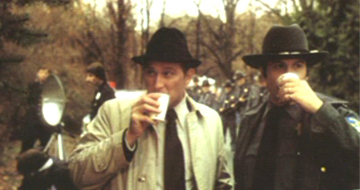
Soon Lt. Riley is on the scene, seeking an end to these Desperate Hours with the help of the local authorities. But when Riley discovers (while making an attempt to listen in on the domicile’s denizens via a parabolic microphone slightly smaller than the Hubble telescope) that the Turners have turned tables on their captors, he throws the rulebook out the window and lets them swing away – which sets the stage for one of my favorite moments in the film.
Riley keeps the law at bay while the family punishes their attackers – but it only goes so far. Eventually, the boys in blue wanna’ hit the house. In that moment, young master Blythewood appears at the front door, tears in his eyes, pleading for the 5-O to stand down.
“Please officers – please don’t come any closer! They’re gonna’ kill my mom and dad!”
And as he moves away from the door, he looks RIGHT INTO CAMERA, and smiles.
Holy. Shit. Movie – you’re awesome.
Things come to an end much like you’d expect they would – with violent deaths for the Donka and his gang. Chino spends what feels like the bulk of the third act rolling around on the floor, screaming and clutching what’s left of his bleeding balls…Ling feels “pane” in his abdominal region, and Kane…well, you couldn’t have paid me to take that squib hit. In the end, the only thing missing is Minister Ted Turner declaring that he’s going to build a church on the site of the tragedy – ’cause, yeah…Virgin Spring all over this thing.
There are elements of the production that are a bit off due to the brutally low budget (the fights and stunts don’t work quite like they should, perhaps) – but seldom does an exploitation thriller transcend the confines of its limitations like this one. The film delights in showing the audience a reflection of itself in a funhouse mirror. So many exploitation films try to jolt an audience – but Fight For Your Life really does – and it accomplishes its task not with half-assed splatter or brutal rape – it does it with ideas. It does it with dialogue. It does it with performance. It does it with all of the things that are supposed to sink a low-budget film.
There’s a legitimate case to be made for this film possessing a sort of a Harold Pinter vibe (it could easily be described as a “comedy of menace”). The dialogue (normally something that is atrocious – or, best case scenario, superfluous in a “B” film) has an almost…Mamet-like (Mamet-esque? Mametian?? Mametarian?) quality to it. It defines the characters, is brutally frank, and it happens to be infinitely quotable. Though no one in their right mind could suggest any sort of direct influence, Fight For Your Life shares a lot of ideas with Mamet’s output with regard to race relations – and it comes to some of the character moments in a similar manner. Dialogue that seems to have little meaning in the grand scheme of things turns out to be what the piece is all about. Some of it belongs on a T-Shirt…that you’d get the living shit beat out of you for wearing, but…
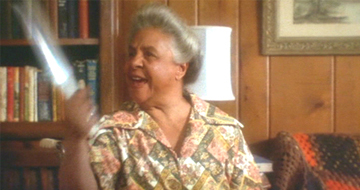
I might wear a garment emblazoned with, “Give me a pig-sticker for that pink pig!“
Perhaps this is over-intellectualizing the thing – maybe the whole point of the film was just to start a riot on 42nd Street – to create as much of a pressure-cooker in the theater as there was on screen? After all, the producers went so far as to cut different trailers for different, uh…how you say…segments…of the audience.
Let’s examine how this jobbed out, exactly.
Trailer #1:
We are a nation wracked with violent crime. You are about to see a small sample of an extraordinary, gut-crunching film that vividly portrays the most sadistic of these criminals. When faced with the terror of brutal killers, every cop – every man – knows that surrender is impossible. You must Fight For Your Life!
Trailer #2:
You are about to see a few moments from an extraordinary, gut-cruching movie that will make you get down and shout, “I am proud to be a Black Man!”
Of course, tons of racist dialogue finds its way into this trailer, and much more of the climactic revenge is on display – including all three criminals’ deaths. Give away the ending, why don’t ya?? All of the violence is punctuated with exclamations like:
YEAH, MOMMA!?
GET ‘IM, POPPA! YEAH!!
And finally, over a title card that reads Stayin’ Alive (hoo-boy):
Hey-hey! Now let’s all stand up and cheer the brotha’ who taught America the meaning of the word courage! Stayin’ Alive – YEAHHHHH!!
Now would you call the implementation of that particular marketing stratagem “audacity” – or would you call it “big balls”?? And would you have to say “big balls” like Steven Seagal in On Deadly Ground?
In the end, it matters not – as I mentioned earlier, the film did not perform during any of its multiple/platformed/territorial theatrical releases (it was retititled and sent out again and again – as the aformentioned Stayin’ Alive…as Blood Bath at 1313 Fury Road…I Hate Your Guts…Getting Even…Hostage…Held Hostage…The Hostage’s Bloody Revenge…nothing seemed to work). Apparently, many theater owners were afraid of a violent reaction to the film. I can’t imagine why. I mean, it’s not like the film is race baiting, or anything…
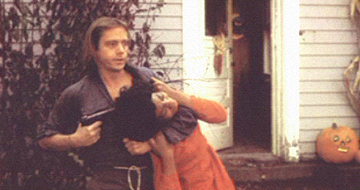
Director Robert Endelson, who cut his teeth on some of that ’70’s “almost mainstream” porno Paul Thomas Anderson was so interested in when he made Boogie Nights, left filmmaking altogether after Fight for Your Life. Apparently, he’s responsible for some sort of breakthrough in dentistry. Writer Straw Weisman has hung out a lot in explo (and hold numerous producer/associate producer credits – the sleeper What the “Bleep” Do We Know!? among them) but nothing he’s done since has achieved the notoriety of Fight For Your Life – a story filled with unbelievable action…a movie of excruciating violence…a saga of extraordinary courage that will leave you cheering. Fight For Your Life – experience it…soon!
When next we descend, we’ll rob from the rich…and pretty much keep it.
CHUD’s Sewer Subterranea wants your films!
Send your DVDs to:
Sewer Subterranea
PO BOX 967
Chesterton, IN 46304
E-Mail Sewer Subterranea
Visit Sewer Subterranea at MySpace